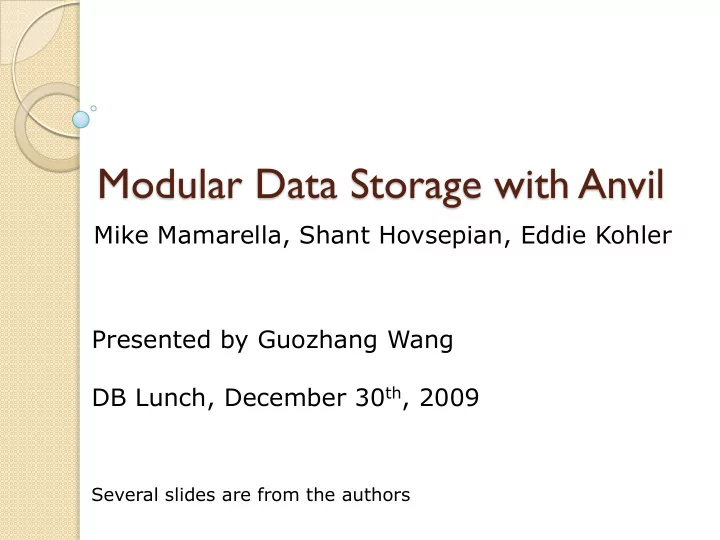

Modular Data Storage with Anvil Mike Mamarella, Shant Hovsepian, Eddie Kohler Presented by Guozhang Wang DB Lunch, December 30 th , 2009 Several slides are from the authors
Motivation Custom Data Stores ◦ can greatly outperform conventional systems by 100x for specific work loads ◦ are often written monolithically What if application has characteristics of both OLTP and warehousing? We need a modular and extensible toolkit to build new data store layouts
Anvil Fine-grained dTables: abstract key/value ◦ Keys are integers, floats, or strings ◦ Values are byte arrays ◦ Iterators support in-order traversal ◦ Most are read only
How to build DBMS from dTable How to build indexing, hashing, etc using dTables? How to handle writes efficiently? How to handle transactions?
#1 dTable Layering dTables can be built over other dTables using the same interface ◦ Storage dTable ◦ Performance dTable
dTable Layering Exception dTable ◦ Combines a “restricted” dTable with an “unrestricted” dTable E.g., want to store the state of residence of customers ◦ Identified by mostly-contiguous IDs ◦ Most live in the US, but a few don’t
Exceptional dTable Restricted handled by array dTables (contiguous integer keys, fixed size values) Unrestricted handled by linear dTables
#2 Writable dTables Isolates all writing to dedicated writable dTables Journal dTable ◦ Append-only store for new/updated data ◦ Periodic “digestion” to read -only dTables when it gets large Combine write-optimized and read-only dTables into single logical dTable: Overlay
Overlay dTable Built over two or more dTables, usually one writable and multi read-only. Iterator merges all underneath dTables ’ iterators for reads Older “lower” data can be overridden by newer “higher” data
#3 Managed dTable Interfaces with transaction library, which keeps transaction logs ◦ Always consistent ◦ User decide durability Also decides policy for digesting journal dTables and combining read-only dTables
dTables in summary Storage dTables: linear, fix-sized, array, memory, journal, etc Performance dTables: b-tree, bloom filter, cache, etc Unifying dTables: exception, overlay, managed
Customer State Residence Example
Modularity Linear + B-tree vs. Array + Exception ◦ Keys: contiguous or spaced 1000 apart
Exception dTable Low Overhead Linear vs. Array vs. Array + Exception Exception dTable is low overhead vs. array but restores full functionality
Read/Write Separation Anvil’s durable and non-durable config outperformes original durable and non- durable config
Questions ?
Recommend
More recommend